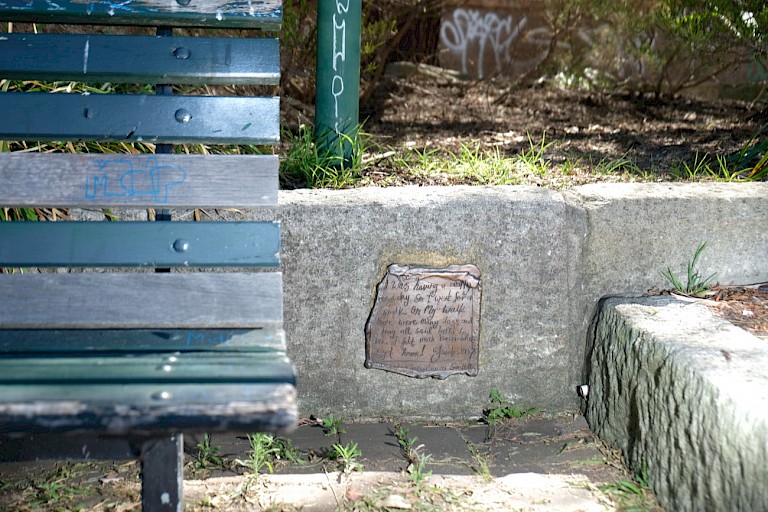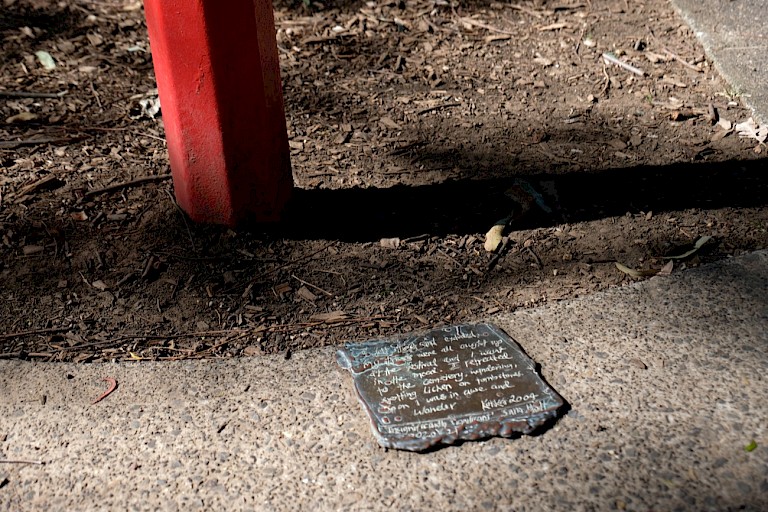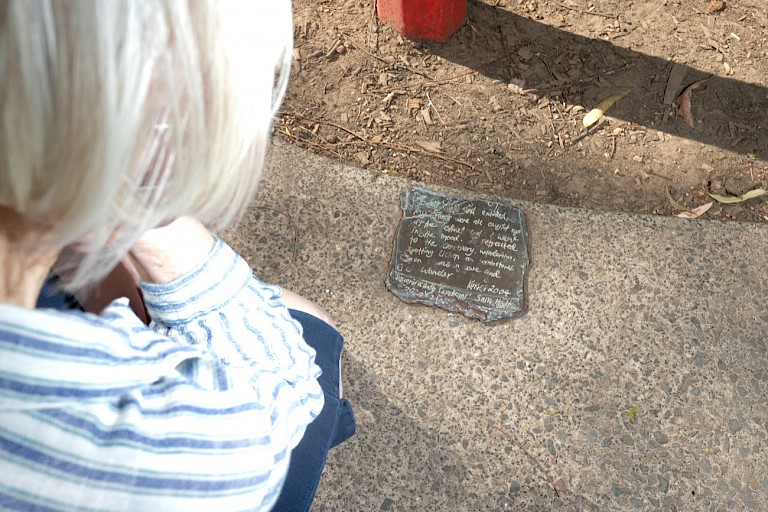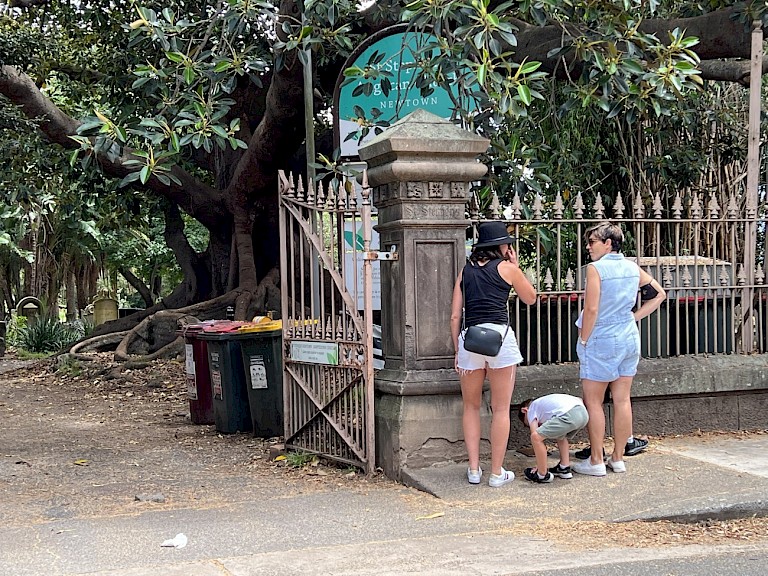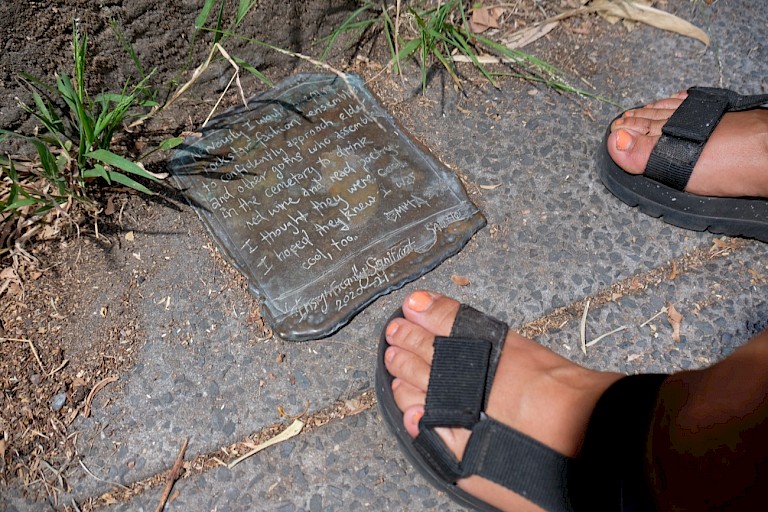



The Artist
Sam Holt is a Sydney-based Australian emerging artist. He completed a Bachelor of Visual Arts at SCA, Sydney, in 2017, including an exchange at the Universität der Künste, Berlin. Awarded the Marten Bequest Travelling Scholarship for Painting in 2017, he once again moved to explore opportunities in Berlin, only recently returning in late 2019 to Sydney. He is represented by Artereal Gallery, Sydney, where his work has been exhibited in numerous prizes and exhibitions and is held in prominent public and private collections both in Australia and internationally.
Insignificantly Significant is a public art project by Australian artist Sam Holt in Sydney's Inner-West, a part of the city to the west of the central business district. Conceived during a COVID-19 lockdown as a memorialisation of the experiences of everyday residents of the Inner West, Holt received a Cultural Resilience Grant and funding from Inner West Creative in 2020 for this project. The artist wanted to engage people with personal memories of the area and made an open call for submissions. Out of 170 submissions, ten were selected, handwritten, cast as bronze plaques and installed in the places where the memories were made.
1. "We wandered down to this park on a random adventure. 2020 has been hard, but as I sat on the bench here, watching my daughter and wife pick and eat mulberries, I knew everything was going to be ok." (Max Mason, Pine Square Playground, Leichhardt)
2. "We sat here after school, ate hot chips and gravy with a fork and listened to Smashing Pumpkins on my dusty old Walkman. I can still hear your joyous laugh and will hold it in my heart forever." (Nicole Isaacs, corner of Brown St. and Hercules St., Ashfield)
3. "I nervously prepared my rockstar fashion ensembles to confidently approach the elder and other goths who assembled in the cemetery to drink red wine and read poetry. I thought they were cool, I hoped they knew I was cool too." (Emma Sputnik, cemetery at St. Stephens Church, Church Street, Newtown)
4. "This is where mum left her car parked in the middle of the road, cos she'd been diagnosed with cancer a few months earlier and no longer gave a F about the small stuff." (George Organ, Cary St., Marrickville)
5. "I felt lost and excluded, my friends were all caught up at the festival and I wasn't in the mood. I retreated to the cemetery, wandering, spotting green moss and lichen on tombstones, soon I was in awe and wonder." (Katika Schultz, Camperdown Park near the cemetery)
6. "February 18, 2003. No ticket, no worries. Sitting in the back streets listening to a sold-out Rolling Stones show for two hours. Singing along with Mick between sips of Resch's and drags of hand-rolled cigarettes. Satisfaction." (Tommy Cehak, Pemmell St., behind Enmore Theatre)
7. "The laneway wasn't paved, just dirt and grass. I used to scrunch up my eyes and pretend I was in the country. If a cat was in the lane, I imagined it was a rabbit." (Megan Hicks, a lane, or right-of-way, off Cavendish St., Stanmore, between house numbers 67 and 69)
8. "Thrill, excitement, trepidation at 9-year-old me walking up and onto the huge stage at Leichhardt Town Hall – to receive Third Place Certificate from renowned radio presenter, Eric Baume, for the Council's Health Week essay competition." (Maureen Dolle, Leichhardt Town Hall, Norton St., Leichhardt)
9. "I'd bought half a dozen oysters I couldn't afford, and I ate them alone in the park. Sunday. Watching groups of friends meet and children play I felt both together and alone. I had just moved out of home." (Aimee Cass, Enmore Park, the gnarled tree with a bench underneath)
10. "I was having a really ruff day. So I went for a walk, on my walk there were many dogs, and they all said hello to me. I felt much better when I got back home." (Farah, a street with a lot of dogs, outside corner of King St. and Lord St.)
According to the artist, “Conceived at the start of COVID the isolation and uncertainty of the world surely had an impact on the conception of Insignificantly significant. At the time I’d been looking at public art opportunities and exploring ideas that would be a natural extension of my expanded painting practice that would continue my focus on time and the interrogation of singular memory and moments… Notably also, I’d only just moved back from living in Berlin for the past 2.5 years on an Art Scholarship and the Stolpersteine plaques by German Artist Gunter Demnig (German meaning: to stumble across something, to find out by chance) were I’m sure subconsciously an influence in the conception of Insignificantly Significant. Demnig had embedded 10x10cm brass plaques into cobblestone pavements that commemorated and were placed where Jewish families had once lived.”
Commemorative plaques have a long history; they have been used over the centuries to memorialise important events, people, and places. In medieval Europe, for example, plaques were used extensively in churches to commemorate religious figures as well as patrons. In more recent times, plaques have been used to mark important monuments and sites and can be found in parks, cemeteries, and other outdoor locations. In discussing Insignificantly Significant, Holt mentions a contemporary project, Gunter Demnig's Stolpersteine (German for "stumbling stones or blocks"), in which brass plaques were placed on pavements in front of the last address of victims of Nazi persecution. (Holt had recently returned to Sydney from Berlin, where he first learned of Demnig's project). While Demnig's plaques memorialised everyday victims of a significant historical event (the Holocaust), Holt's celebrate everyday people's memories of relatively "insignificant" events.
“All my decision-making around the plaques was looking to subvert what people would normally associate with a plaque, being something that signifies an important moment in history, person, or place. Highlighting everyday people and their experiences instead was the essence of the whole project because I truly believe the relatability of these moments and the celebration of them is what is most powerful.” (Holt)
It was important to Holt that not all memories were happy ones, but that altogether the plaques could function as "relatable reminders for the viewer that everyone is dealing with different challenges at any given moment and where they are currently standing this person once experienced this." Insignificantly Significant suggests that "insignificant" memories of everyday people are not "lesser" layers of history nor lesser parts of the fabric of the cultural memory of a place. Certainly, for the participants, their friends and families, the project instilled a new sense of belonging and place. Unassuming in scale (approximately 15cm by 15cm) but embedded in highly accessible neighbourhood locations, the plaques have likely been experienced by thousands since their installation. Holt hopes that the project continues to provide unexpected moments of surprise and reflection as Inner-West residents and visitors stumble upon them in years to come.
“For me they are relatable reminders for the viewer that everyone is dealing with different challenges at any given moment and where they are currently standing this person once experienced this etc. I think it’s this reframed context of the space for the viewer that is the works biggest strength, a reminder that change is a constant and that a seemingly insignificant moment shared, could have a significant impact at any moment on someone else.” (Holt)
Holt estimates that thousands of people would have experienced the works to date, but also observes, “The COVID period certainly gave the project a whole new level of meaning and importance both to individual storytelling, self-worth and connection to the broader community that everyone was longing for in lockdown, whilst it coincided with residents more actively using parks much more.”
